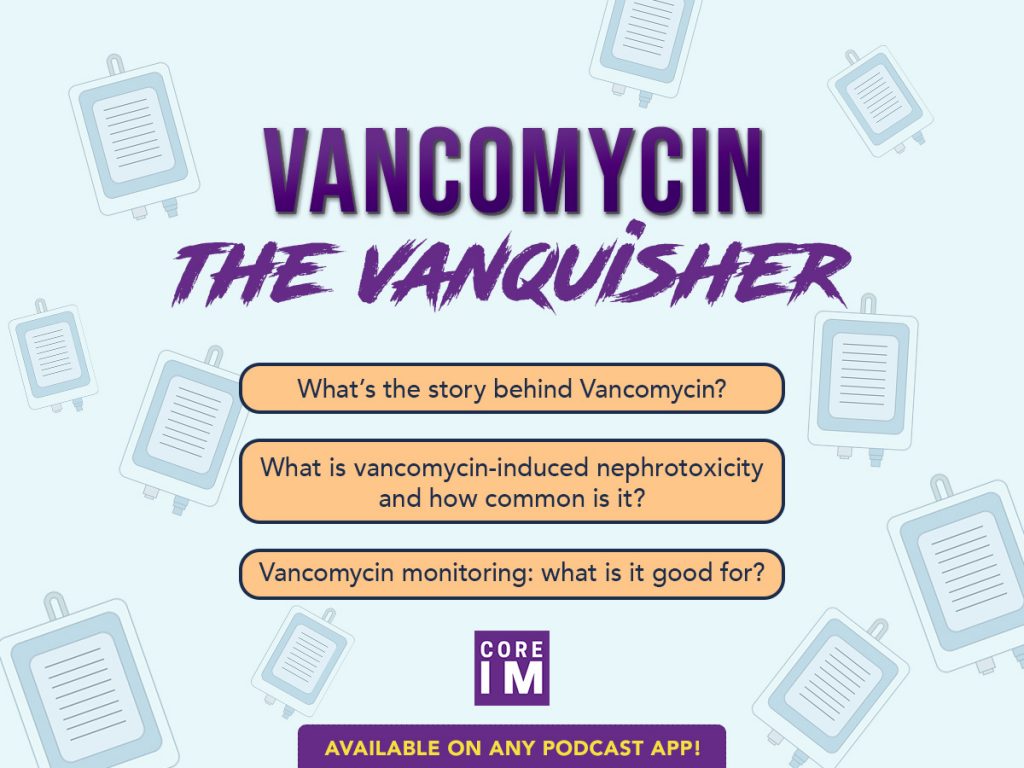Podcast: Play in new window | Download
Subscribe: RSS
 In this episode, we discuss the misunderstood side of our antibiotic hero, Vancomycin || By Steven R. Liu MD, John Hwang MD and Dr. Janine Knudsen MD || Graphic Design by Ramon Thompson
In this episode, we discuss the misunderstood side of our antibiotic hero, Vancomycin || By Steven R. Liu MD, John Hwang MD and Dr. Janine Knudsen MD || Graphic Design by Ramon Thompson
Time Stamps:
- Where did vancomycin come from, and why is it so controversial? (0:28)
- What is vancomycin-induced nephrotoxicity and how common is it? (4:37)
- Vancomycin trough monitoring – what is it good for? (7:28)
- AUC to MIC ratio – the real math behind vancomycin dosing (7:53)
- Review of teaching points (10:27)
Thank you to ID pharmacists from NYU, Polly Shin-Pung Jen, PharmD and Justin Siegfried, PharmD, for peer reviewing this podcast!
Subscribe to CORE IM on any podcast app! Follow us on Facebook @Core IM || Twitter @COREIMpodcast || Instagram @core.im.podcast. Please give any feedback at COREIMpodcast@gmail.com.
Show Notes:
- Initial formulations of vancomycin were only 70% pure, giving it its original muddy brown color. Side effects seen included cytopenias, “red man syndrome”, and nephrotoxicity. With better technology, vancomycin is now 95% pure, and as a result has fewer side effects.
- Vancomycin nephrotoxicity is defined by the IDSA as an increase in creatinine of 0.5mg/dL or by more than 50%, whichever is bigger.
- Vancomycin causes nephrotoxicity through two mechanisms: acute interstitial nephritis (an allergic reactions) or renal tubular damage from oxidative stress.
- Rates of nephrotoxicity appear to be low, although the exact number is difficult to determine. Most studies are retrospective or observational, and the few RCTs available may be subject to confounding.
- Risk factors for nephrotoxicity include concomitant use of aminoglycosides or piperacillin/tazobactam, rates at or above 4g per day, duration of therapy, and critical illness, among others.
- Vancomycin peaks do NOT correlate with toxicity or efficacy. Instead, this depends on the AUC/MIC ratio.
- The AUC (area under the curve) represents the amount of drug the bacteria see over a 24 hour period. The MIC (minimum inhibitory concentration) represents how resistant the bacteria are to that antibiotic.
- The AUC/MIC ratio is the best measurement of vancomycin’s effectiveness. The current rationale for checking vancomycin troughs is as a cheap, practical, but suboptimal surrogate marker for the AUC/MIC.
References:
(0:42) Levine DP. “Vancomycin: a history.” Clinical infectious diseases: an official publication of the Infectious Diseases Society of America 2006;42 Suppl 1:S5-12.
(3:08) Cheung RP, DiPiro JT. “Vancomycin: an update.” Pharmacotherapy 1986;6:153-69.
(4:59) Rybak MJ, Lomaestro BM, Rotschafer JC, et al. “Vancomycin therapeutic guidelines: a summary of consensus recommendations from the infectious diseases Society of America, the American Society of Health-System Pharmacists, and the Society of Infectious Diseases Pharmacists.” Clinical infectious diseases: an official publication of the Infectious Diseases Society of America 2009;49:325-7.
(5:16) Sinha Ray A, Haikal A, Hammoud KA, Yu AS. “Vancomycin and the Risk of AKI: A Systematic Review and Meta-Analysis.” Clinical journal of the American Society of Nephrology 2016;11:2132-40.
(5:52) Cheung et al, 1986. (see above)
(6:08) Lodise TP, Lomaestro B, Graves J, Drusano GL. “Larger vancomycin doses (at least four grams per day) are associated with an increased incidence of nephrotoxicity.” Antimicrob Agents Chemother. 2008 Apr;52(4):1330-6.
(6:08) Carreno JJ, Kenney RM, Lomaestro B. “Vancomycin-associated renal dysfunction: where are we now?” Pharmacotherapy. 2014 Dec;34(12):1259-68.
(8:25) Moise-Broder PA, Forrest A, Birmingham MC, Schentag JJ. “Pharmacodynamics of vancomycin and other antimicrobials in patients with Staphylococcus aureus lower respiratory tract infections.” Clinical pharmacokinetics 2004;43:925-42..
(9:20) Kullar R, Leonard SN, Davis SL, Delgado G Jr, Pogue JM, Wahby KA, Falcione B, Rybak MJ. “Validation of the effectiveness of a vancomycin nomogram in achieving target trough concentrations of 15-20 mg/L suggested by the vancomycin consensus guidelines.” Pharmacotherapy. 2011 May;31(5):441-8.
(9:20) Yoon S, Park KR, Lee S, et al. “Assessment of Appropriateness of an Initial Dosing Regimen of Vancomycin and Development of a New Dosing Nomogram.” Basic & clinical pharmacology & toxicology 2017.
(9:32) Neely MN, Youn G, Jones B, et al. “Are vancomycin trough concentrations adequate for optimal dosing?” Antimicrobial agents and chemotherapy 2014;58:309-16.

One comment on “Core IM: Mind the Gap on Vancomycin”
great info! for pharmacist monitoring, a standard protocol designed to hit trough goal 10-15 for uTI or 15-20 endocarditis, worse. Do you recommend hospital pharmacist develop and implement a protocol or defer to ClinCalc or similar download-able calculator?
Thanks for your input
Comments are closed.